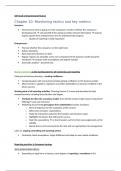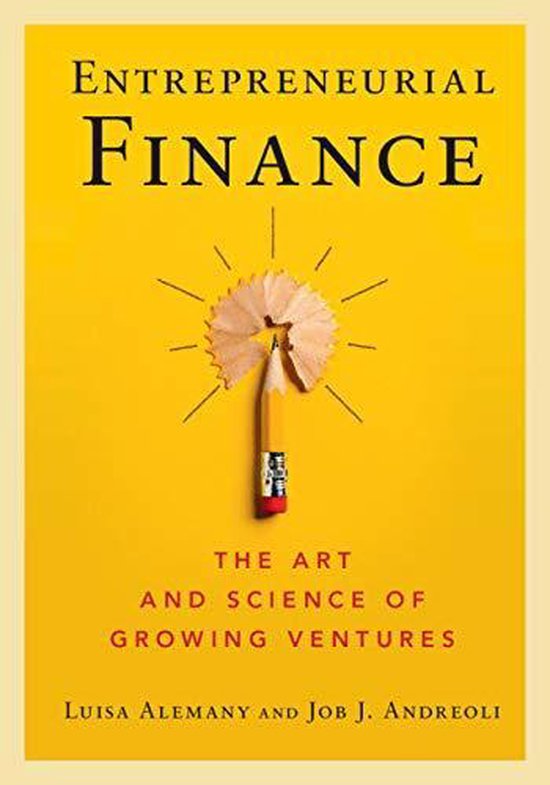Self-study entrepreneurial finance
Chapter 10: Monitoring tactics and key metrics
Investors:
Need to know what is going on in the companies: monitor whether the company is
developing well. only possible if the startup provides relevant information requires
regular reports from entrepreneurs: lens to understand the progress.
o Quality of reporting is really important!
Entrepreneur:
Find out whether the company is on the right track.
Enforce discipline.
Base important decisions on facts.
Regular reports are advisable: every core component of the business model should be
monitored compare with assumptions and adapt if needed.
Good data analysis = powerful tool.
Business planning as the starting point for all monitoring and reporting
Main goal of business planning = creating confidence.
Comparing plans with real outcomes helps gaining confidence in the business model.
Allow investors, suppliers, employees and other stakeholders to become confident in the
future success.
Starting point of all reporting activities. Planning horizon 3-5 years and describes the idea
comprehensively, including financial plans and targets.
Translate the idea into a business model: how will the venture make money? Customers?
Offerings? Costs and revenues?
Marketing document to get support from stakeholders (mainly: investors):
o Point of departure for the evaluation of the venture;
o Determines investors’ expectations.
o Make the interactions between the founders and investors easier.
o Highlights the factors that will lead to success.
o State the assumptions so that investors can form their own judgements on the
viability.
o Openly discuss and communicate the risks and use appropriate risk management.
Later on: ongoing controlling and reporting system.
Constantly check assumptions, target fulfilment and adapt to new market conditions.
Reporting practices in European startups
Some general observations:
Depending on legal form of startup, some degree of reporting is mandatory in EU.
, o However, mostly limited to annual report, shareholder meeting and accounting
numbers.
Dominant principle: compliance to accounting standards: but comes too late:
focuses on past performance, not forecasting future performance.
The unit of analysis is the whole company, not a unit/business model/
customer segment/ …
Frequently almost impossible to derive information on the success of
individual products/business models/ strategies.
o And most startups do not report beyond legal requirements!
Reasons: not knowing what investors expect, takes up too much of their
time, not knowing what metrics, mistakenly believe investors only want to
hear good news, …
o When professional investors are involved: standardized reporting practices are the
norm.
Investment contract specifies guidelines on reporting (form, timing, content)
Standard practice: monthly & written.
Business associations provide guidelines: voluntary, encourage thorough
reports.
Often requiring investors to give feedback: two-way communication.
o Reporting is not only written: often complemented with verbal reporting.
Meetings and calls.
Cannot replace written reports!
The board time is valuable: send out reports in advance and use board time
to discuss points that require further clarification.
Quantitative reporting practices:
Essential part of reporting: metrics and key ratios.
Input-oriented (f.ex: how many people the company employs)
Output-oriented (f.ex: sales)
o Revenue run rate = how are sales developing over time? Is the business scaling well?
Meet forecasts?
Seasonal patterns?
Stable growth rates?
o Average revenue per user
Can be broken down by channel or segment.
o Net revenue = excludes VAT and other returns that will not lead to income streams
for the firm.
Metrics on the costs associated with generating revenue.
o CAC
Monitor how efficient the sales process and sales team are.
May go down over time with better brand awareness and improved sales
processes improve profitability.
o Churn rate = % of customers a company loses per month or per year.
= 1- retention rate.
, Shows whether the startup is able to keep the customers it has acquired.
The lower the better = loyal and satisfied customers.
Also relevant: the trend in churn rate! Should descend over time.
o Customer profitability: very important! Illustrates that the company is able to make
money from its customers.
Financial success measures: valuation and chances of survival. (most financial metrics apply
to both dimensions).
o Cash flow: cash is king!
May be negative, if external funding to finance growth is provided in time.
o Burn rate:
Describes a negative cashflow situation: money outflows > inflows.
How much time remains before the startup’s current funds are spent and the
company runs out of money.
o Absolute profits and profit margins per product or service: indicator that there are
challenges: too high administrative costs, too much spending on scaling, too low
prices, …
Compare with industry benchmarks! (however: each venture has specific
characteristics!)
Qualitative reporting practices
= Helps to interpret quantitative statements and describes the situation more comprehensively.
Usually includes monthly mail to investors with a general outline: progress of the venture,
challenges, current focus, potential contingency plans, …
o A description of different areas may be included as well.
Often: highlights for each domain in concise bullet-points.
Typically focus on positive aspects and progress impressing and conveying
enthusiasm.
Balanced picture could be better: where can the investors support?
Some success factors of startups do not readily translate into metrics!
o A lot of elements of the strategy cannot be captured in quantitative metrics: general
market trends not captured by KPI’s, quality of leadership, progress on innovation
projects, customer insights, …
o Business functions like HR: employee satisfaction, …
o Competitive threats: new competitors/technologies report on what’s happening
and potential counter measures.
Key metrics
Measuring performance as the ultimate goal
Why?
Guide you in strategic decision-making and show whether your business model is working.
o Might indicate that you need to change direction.
Helps monitoring employee performance and effectiveness manage business in a more
objective way.






